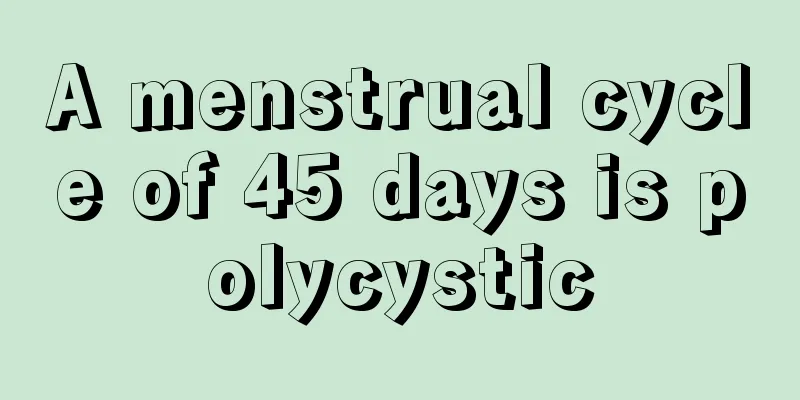A menstrual cycle of 45 days is polycystic

|
Under normal circumstances, a woman's menstrual cycle is 28 days. A menstrual cycle of 45 days is considered irregular menstruation. It may also be a disease of polycystic ovary. Women need to pay attention to vaginal examinations to avoid the symptoms of polycystic ovary. When the follicles develop late, the menstrual cycle will be delayed. Women need to undergo continuous B-ultrasound examinations. You can learn about the causes of delayed menstruation. The menstrual cycle is 45 days. If the cycle is relatively regular and menstruation occurs normally, it does not necessarily mean that you have polycystic ovary syndrome. Polycystic ovary is a complex endocrine disease that generally causes symptoms such as infrequent menstruation, anovulation, obesity, and long body hair. It is recommended that if you are planning to get pregnant, it is best to go to the hospital for gynecological examinations to rule out polycystic conditions and then treat the symptoms under the guidance of a doctor. If the menstrual cycle is long, the development of the follicles will be relatively late. In your case, continuous monitoring can be performed through vaginal B-ultrasound. If the follicles do not develop well this month, you can have a blood test on an empty stomach the day after your next menstrual period. There are standards for the diagnosis of polycystic ovary syndrome, including infrequent ovulation or anovulation, manifestations of hyperandrogenism, and polycystic changes in the ovaries. If two of these are met, polycystic ovary syndrome can be diagnosed. If the menstrual cycle is 45 days and it comes on time, and there is no sign of polycystic ovary on color Doppler ultrasound, then polycystic ovary cannot be diagnosed. Women with polycystic ovary syndrome often have clinical manifestations such as amenorrhea, hirsutism, obesity and infertility. If women have these symptoms, they should go to the hospital in time to find out the cause and receive symptomatic treatment. If we talk about clinical manifestations, the first is infrequent ovulation, or continuous anovulation. This is one condition. There are also manifestations of high androgen levels, including acne and heavy hair. There is also polycystic changes in the ovaries. If two of these three conditions are met, and other endocrine abnormalities are ruled out, such as adrenal problems, thyroid problems, and prolactin problems, and other endocrine abnormalities are ruled out, and the patient meets the characteristics I just mentioned, then polycystic ovary syndrome can be diagnosed. How to treat polycystic ovary syndrome Obesity is an important symptom of polycystic ovary syndrome, so increase exercise to lose weight and correct endocrine and metabolic disorders aggravated by obesity. Losing weight can restore ovulation in some obese patients. Traditional Chinese medicine treatment can counteract the effects of androgens, promote ovarian ovulation, and adjust the menstrual cycle. After the hormone level test is normal, you can stop taking the medicine. The irregular menstruation and infertility symptoms of polycystic ovary syndrome are fundamentally due to insufficient kidney qi and stagnation of liver qi. Because the kidneys are not only related to the reproductive function regulated by the hypothalamus-pituitary-ovarian axis, but also to the development of other parts of the body including the brain, and are also affected by factors such as thinking, emotions, and environment. Therefore, internal and external factors can affect the regulation of menstruation through the kidneys. At the same time, according to the TCM understanding of "liver and kidney are of the same origin", in some patients with menstrual disorders, in addition to insufficient kidney qi, they also show symptoms of liver depression and fire. Kidney deficiency cannot evaporate the body fluid in the lower part of the body, which accumulates into phlegm. Therefore, polycystic ovary manifests as obesity and enlarged ovaries. In addition to kidney deficiency, the disease also has symptoms of blood stasis in the meridians, such as scanty menstruation and amenorrhea. Therefore, it is generally believed that polycystic ovary syndrome is caused by kidney deficiency, among which there are also distinctions between liver depression, phlegm and dampness, and blood stasis. It stimulates regular menstruation and the shedding of the endometrial layer (which needs to happen at least every three months to prevent endometrial abnormalities and endometrial cancer), which is beneficial to fertility. In Western medicine, surgical treatment is performed by puncturing the follicles under laparoscopy to reduce the level of androgen, thereby achieving the treatment goal. |
<<: Why do my nipples hurt? My breasts don't hurt.
>>: Can you feel the fertilized egg combining?
Recommend
How to treat closed comedones in girls quickly
Closed comedones are a relatively common type of ...
Treatment for pregnant women who can't sleep at night
It is a very serious situation for pregnant women...
What foods can cure polycystic ovary syndrome?
When female friends are troubled by polycystic ov...
Standard weight for girls 1.65 meters tall
For girls, if they are 1.65 meters tall, this is ...
What causes low white blood cell count in women?
Health has always been the most important thing f...
How to treat uterine horn adhesions?
The uterus is a reproductive organ in a woman'...
Tom's Hardware: Android mobile browser performance test data comparison
Unlike the iOS platform, there are many browser a...
If you have these 7 symptoms, it means your body is reminding you that you are lacking this nutrient! Check yourself now
Do you often feel drowsy, unable to satisfy your ...
The difference between follicle expulsion and atrophy
There is a big difference between the problem of ...
Female lower abdominal pain after urination
Many women say that they experience varying degre...
Does coughing during pregnancy affect the fetus?
Cough is a very common symptom that can occur alo...
How big is an ovarian cyst to be malignant?
Uterine and ovarian tumors are common tumors of t...
What causes flat chest?
Women with flat chests are probably often critici...
12 days after normal delivery, lochia and blood
Pregnant women will have lochia after giving birt...
What tests are done for arrhythmia? Is arrhythmia a fast or slow heartbeat?
Arrhythmia is easy to understand. It means that t...









